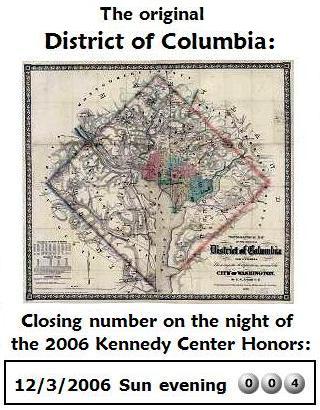
St. Thomas Becket’s day–

“Ed Rinehart [sic] made a fortune painting canvases that were just
one solid color. He had his black period
in which the canvas was totally black.
And then he had a blue period
in which he was painting the canvas blue.”
Wallace Stevens,
“Esthétique du Mal, XI”–
“We are not
At the centre of a diamond.”

The map shows the original
(pre-1846) diamond shape
of the District of Columbia.
For the relevance of the
closing number of “Candide”
to diamonds, see
the previous entry.
For the relevance of the
closing number of the
12/3/06 DC lottery, see
Theme and Variations.
For the relevance of the
earlier mid-day number,
see the conclusion of
“Esthétique du Mal” –
| “And out of what one sees and hears and out Of what one feels, who could have thought to make So many selves, so many sensuous worlds, As if the air, the mid-day air, was swarming With the metaphysical changes that occur, Merely in living as and where we live.” |

A search on the mid-day number
in the context of metaphysics
yields the following:
Related material:
– Conversations with the Dead:
The Ontological Substructure of
Wallace Stevens’s “Esthétique du Mal“–
a 1999 Master’s thesis
For further remarks on
ontological substructure,
see A First Class Degree
(on a notable graduate of
Christ Church, Oxford).
“For every kind of vampire,
there is a kind of cross.”
– Thomas Pynchon
Today is the feast
of St. Thomas Becket.
In his honor, a meditation
on tools and causation:
– Review by H. Allen Orr in
The New York Review of Books,
Vol. 54, No. 1, January 11, 2007
“An odd extension”–
Wolpert’s title is, of course,
from Lewis Carroll.
Related material:
“It’s a poor sort of memory
that only works backwards.”
– Through the Looking-Glass
An event at the Kennedy Center
broadcast on
December 26, 2006
(St. Steven’s Day):

“At times, bullshit can
only be countered
with superior bullshit.”
— Norman Mailer
“The concept of possible worlds dates back to at least Leibniz who in his Théodicée
tries to justify the apparent imperfections of the world by claiming
that it is optimal among all possible worlds. Voltaire satirized this
view in his picaresque novel Candide….
Borges’ seminal short story El jardín de senderos que se bifurcan (“The Garden of Forking Paths“) is an early example of many worlds in fiction.”
“Il faut cultiver notre jardin.“
– Voltaire
“We symbolize
logical necessity
with the box ![]() )
)
and logical possibility
with the diamond ![]() ).”
).”
“The possibilia that exist,
and out of which
the Universe arose,
are located in
a necessary being….”
— Michael Sudduth,
Notes on
God, Chance, and Necessity
by Keith Ward,
Regius Professor of Divinity,
Christ Church College, Oxford
(the home of Lewis Carroll)
For further details,
click on the
Christ Church diamond.
Today in History
by The Associated Press:
Today is Tuesday, Dec. 26, the 360th day of 2006. There are five days
left in the year. The seven-day African-American holiday Kwanzaa begins
today. This is Boxing Day.
A picture from a set of
five Log24 entries ending,
at 2:56 AM on
Sept. 18, 2004, with an
entry on Brown titled
“Soul at Harvard“–
“In one way or another, all
of the work we publish navigates what essayist Guy Davenport called
the ‘Geography of the Imagination.’ (‘The imagination
has a history, as yet unwritten, and it has a geography, as yet only
dimly seen.’)” –Ibis Editions
1 Corinthians 13 and…